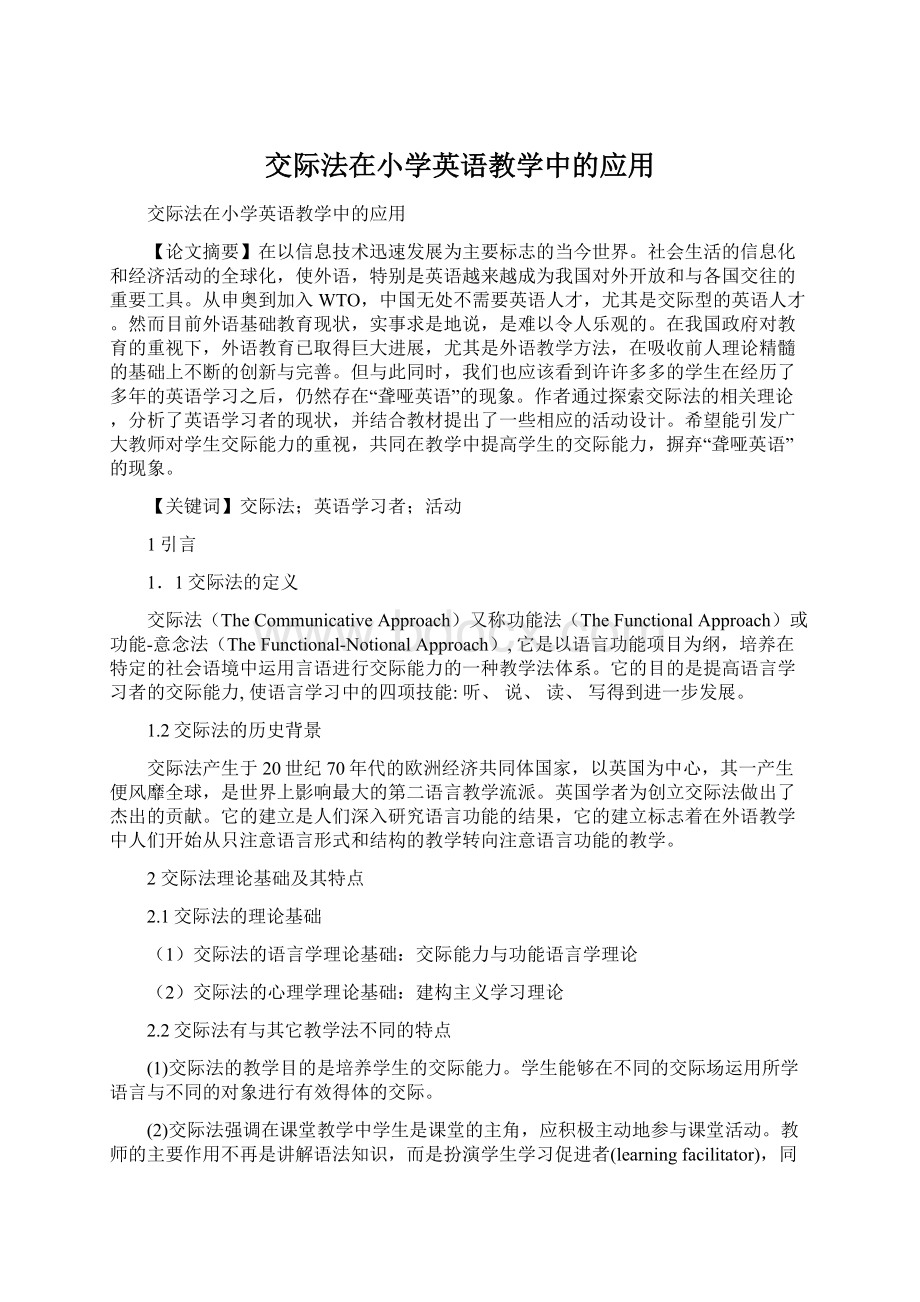交际法在小学英语教学中的应用.docx
《交际法在小学英语教学中的应用.docx》由会员分享,可在线阅读,更多相关《交际法在小学英语教学中的应用.docx(10页珍藏版)》请在冰豆网上搜索。

交际法在小学英语教学中的应用
交际法在小学英语教学中的应用
【论文摘要】在以信息技术迅速发展为主要标志的当今世界。
社会生活的信息化和经济活动的全球化,使外语,特别是英语越来越成为我国对外开放和与各国交往的重要工具。
从申奥到加入WTO,中国无处不需要英语人才,尤其是交际型的英语人才。
然而目前外语基础教育现状,实事求是地说,是难以令人乐观的。
在我国政府对教育的重视下,外语教育已取得巨大进展,尤其是外语教学方法,在吸收前人理论精髓的基础上不断的创新与完善。
但与此同时,我们也应该看到许许多多的学生在经历了多年的英语学习之后,仍然存在“聋哑英语”的现象。
作者通过探索交际法的相关理论,分析了英语学习者的现状,并结合教材提出了一些相应的活动设计。
希望能引发广大教师对学生交际能力的重视,共同在教学中提高学生的交际能力,摒弃“聋哑英语”的现象。
【关键词】交际法;英语学习者;活动
1引言
1.1交际法的定义
交际法(TheCommunicativeApproach)又称功能法(TheFunctionalApproach)或功能-意念法(TheFunctional-NotionalApproach),它是以语言功能项目为纲,培养在特定的社会语境中运用言语进行交际能力的一种教学法体系。
它的目的是提高语言学习者的交际能力,使语言学习中的四项技能:
听、说、读、写得到进一步发展。
1.2交际法的历史背景
交际法产生于20世纪70年代的欧洲经济共同体国家,以英国为中心,其一产生便风靡全球,是世界上影响最大的第二语言教学流派。
英国学者为创立交际法做出了杰出的贡献。
它的建立是人们深入研究语言功能的结果,它的建立标志着在外语教学中人们开始从只注意语言形式和结构的教学转向注意语言功能的教学。
2交际法理论基础及其特点
2.1交际法的理论基础
(1)交际法的语言学理论基础:
交际能力与功能语言学理论
(2)交际法的心理学理论基础:
建构主义学习理论
2.2交际法有与其它教学法不同的特点
(1)交际法的教学目的是培养学生的交际能力。
学生能够在不同的交际场运用所学语言与不同的对象进行有效得体的交际。
(2)交际法强调在课堂教学中学生是课堂的主角,应积极主动地参与课堂活动。
教师的主要作用不再是讲解语法知识,而是扮演学生学习促进者(learningfacilitator),同时在不同的场合还扮演不同的角色,如导演(director)、咨询者(counselor)、参与者(participant)等。
(3)交际法强调语言的流利性(fluency),忽略语言的准确性(accuracy)。
课堂上教师鼓励学生大胆开口说话以培养交际能力,而不需要急于纠正学生出现语言错误,以免影响学生的思路和积极性。
(4)交际法以交际活动为课堂主要方式,选用的材料具有真实性,根据人们处理这些真实材料的行为方式提供丰富多彩的课堂活动,有双人活动(pairwork)、小组活动(groupwork)、班级活动(classactivity)、角色扮演(roleplay)、短剧(shortplay)、讲故事(storytelling)、采访(interview)、交流活动(interchangeactivities)等,让学生在真实自然的语言环境中运用语言知识。
(5)交际法重视对目的语(targetlanguage)国家文化的学习,同时注意介绍中西文化差异和培养跨文化交际知识,以便进行有效且恰当的口头或书面交际,避免受本国文化的影响,在交际过程中出现理解的误差或差异。
交际法教学是以上教学理论和教学原则为切入点,依据学生的接受情况,使教学内容最大限度地、适时地、恰到好处地去适应和促进学生的智能发展,真正作到使教法、学法、记法融为一体,使每一个学生学有所得,增强学生英语应用能力的提高的一种有效方法。
3英语学习者的现状
学语言目的在于能熟练地应用语言进行日常交际。
然而,学生平时却是有时或偶然地开口讲英语,而且不能随心所欲地说英语。
甚至听不懂别人讲英语。
部分学生从小学就开始学英语,学了七年八年,到目前还是似懂非懂,稀里糊涂。
有人虽然笔试会得高分,但需要运用英语时却出现“聋子英语”——听不懂和“哑巴英语”——说不出等现象。
即所谓的聋哑英语。
这不能不说是我们实际教学中的一大遗憾。
这也说明了我国英语教育的现状尚不能适应我国经济建设和社会发展的需要,与时代发展的要求还存在差距;在实际教学中还存在许多弊端。
大多数学生在讲英语中害怕犯错误,其实这也是他们口语学不好的症结所在。
学生担心自己的语音不如人,以致怕“开口”,怕一“开口”就“出错”,羞于“开口”。
其实,犯错误是语言学习过程中必然产生的现象。
杜雷和贝特(DulayandBurt)说:
“不犯错误是学不会语言的。
”因而,作为教师,应明确地向学生指出,学语言不存在对与错,只要能说出来,意思让人家明白就可以了。
当然在交流中,应尽量避免全局性的错误,即会造成交际过程中误解的错误。
至于局部的错误,随着语言学习的发展,自然会逐步解决。
学习者只有在不断的犯错误中语言能力才能得以提高,才能把语言学好。
教师在课堂教学中,对学生所犯的部分小错误不要过于看重、刻意指出,或当众当面提出,久而久之,会极大地挫伤学生讲英语的积极性,使他们缩头缩尾,不敢开口讲,或随心所欲地讲英语。
这给他们在学英语时造成极大的障碍,不利于他们口语的提高。
作为教师,必须注意到这方面的负面影响。
4交际教学法在口语教学中应处理的三对主要关系
4.1师生关系
交际教学法强调的是学生的口语表达能力的提高。
作为一名教师,他是课堂组织者。
而作为一个学生,他是教学活动的主体,教学信息的反馈者。
总之交际教学法口语教学的实施过程中是教师和学生、学生和学生之间的相互依赖、相互帮助、相互促进的过程。
4.2准确性与流利性
传统的教学相对交际教学法来讲,更加侧重语言的准确性。
教学过程中,教师时时监控学生的语言准确性,遇到学生口语上的错误,马上帮助学生改正。
长期如此会让学生有所顾虑,甚至每位学生在说话之前会先考虑好自己要讲的内容,然后表达出来,而不是所谓的脱口而出,自由地交谈。
因此,过分强调语言的流利性将会妨碍语言的自然使用。
只有完整地使用语言来完成互相之间的交流才算是真正的交际。
因此交际教学法在英语口语教学中要处理好学生语言的准确性和流利性之间的关系。
要做到在确保学生语言的流利性的基础上,通过一定的语言知识的学习,达到学生使用语言的准确性。
4.3学得与习得
英语口语教学有别于其他如语法和阅读等的教学。
学生可以通过学得掌握一些语言知识,但是并不表示学生能够流利地把语言知识用口语表达出来。
口语的提高更重要的还是要依赖一定的语言环境,并在语言环境中进行长期的演练。
如通过课堂上师生之间的对话交流或者课外通过参加英语角等活动,让学生获得更多一点的语言输入,鼓励学生在潜意识上对语言的习得。
5交际法在英语教学课堂上的活动设计
5.1Activity1AFieldTrip
1.Teachingmaterials:
Textbook:
PEPBook6
Subject:
Unit6AFieldTrip
2.TeachingAims:
Beabletolisten,readandwritethephrases:
countinginsects,collectingleaves,writingareport,playingchess,havingapicnic.
3.Teachingpreparation:
Tape,recorder,vocabularycard,leaves,chess.
4.TeachingSteps:
Step1Warm-up
(1)Greetings:
E.g.:
hello!
Howareyou?
Whatareyoudoing?
…
(2)Revision:
Makephraseswiththegivingwords:
E.g.:
make→makefriends
take,make,do,catch,pickup,watch,play,have,write
Lookatthepicturesandmakeashortdialogue:
fivepicturesofALet’slearn
Step2Presentationandpractice
(1)T(accordingtothepicturefromthebook):
Wherearethey?
Aretheyatschool?
Oh!
Theyaregoingonafieldtrip.Let’sgoonafieldtrip,too.OK?
Ss:
OK!
T:
Butfirstwemustknowtheweather.Let’slookattheweatherreport:
(Showtheweatherreport:
Oh!
Itsaysit’ssunnytoday.Sowecangoonafieldtrip.
Tolearntheword:
report,writingareport.
(2)T:
Oh!
It’stimetogo.ButIwanttoknowhowmanyboysandgirls?
Whocanhelpmetocounttheboysandgirls?
xx,canyouhelpmetocounthowmanyboysandgirls?
S1:
Yes.(Thenbegintocount.)
T:
Whatisshedoing?
Sheiscountingtheboys.(AskS1)Howmanyboys?
S1:
Thereare_____.
T:
Nowpleasecountthegirls.(Askthewholeclass)Whatishedoing?
(leadingthestudentstospeak)Heiscountingthegirls.(askS2)Howmanygirls?
S2:
Thereare_______.
Tolearntheword:
count,countingtheboys/girls.Thenmakephraseswith“count”.
(3)Ok!
Let’sgo!
Oh!
Look!
Whoarethosetwogirls?
Whataretheydoing?
Aretheycountinginsects?
Ss:
No,theyaren’t.
T:
Whataretheydoingthen?
Oh,theyarehavingapicnic.
Tolearnthephrases“havingapicnic”.
(4)Let’ssayhellotothem.OK.Let’sgo.(showapictureofawoods)Wow!
Somanycolorfulleaves.Let’spickuptheleaves.Ok.Ipickedupalotofleaves.Ilikethis(thenputtheleavesintoabook)Ask:
WhatamIdoing?
I’mcollectingleaves.(Repeat)
Tolearnthephrase:
collectingleaves.
(5)Showchess:
Look!
Thisischess.Canyouplayit?
Canyouplaychess?
Ss:
Yes,Ican.
T:
Ifweplaychess,howmanypeopleatleast?
Ss:
Two.
Tolearnthephrase:
playchess.
Practice:
(1)Showthewholepictureoneminutetoletthestudentsrememberthepicture.Thenasksomequestionsaboutthepictureandchecktheanswer.
(2)Let’splay:
Onestudentmakeasentenceaccordingtothephrase,thenextonedothewayaccordingtoanotherphrase,othersdothesameway,andthelastonesay…iswritingareport.
(3)Continuefollowthelastpart___iswritingareport.Canyouwriteareport,too?
Ss:
Yes,wecan.
T:
Nowyou’regoingonafieldtrip.Youcanplayinyourgroup.Onestudentwriteareport,theothersdotheaction.Youcanwritethereportlikethis:
Date:
Where:
who
doing
givethestudentsthreeminutes)
(4)Saythereport.
(5)Pronunciation.
5.Homework
(1)Readandrememberthewordswithyourclassmates.
(2)CopythewordsinBookA.
5.2Activity2WelcomeBacktoSchool
1.Teachingmaterials:
Textbook:
PEP3
Subject:
Unit1WelcomeBacktoSchool
2.TeachingAims:
(1)Beabletounderstandandsay:
Wehaveanewfriendtoday.I’mfrom….Welcome!
(2)Beabletointroduceyourselftoothers.
(3)ImproveSs’intercourseabilities.
3.TeachingPreparation:
TheinternationalflagofAmerica\Canada\China.
4.TeachingSteps:
Step1Warm–up
(1)Singasong“Goodmorning”
(2)Greetings.
(3)Freetalk
Teacher:
Goodmorning,boysandgirls.Welcomebacktoschool.
Nicetomeetyouagain!
Students:
Nicetomeetyou,too.
Teacher:
Hi,girl.Myname’sWendy.MayIhaveyourname?
StudentA:
Sure.Myname’s……
Teacher:
Hi,Welcomebacktoschool!
……
Step2Presentationandpractice.
(1)ContinuetheFreetalktoleadin:
Teacher:
Look!
Ihaveanewbook!
Doyouhaveanewone?
Student:
Yes.Ihaveanewbook.
Teacher:
Thisisanewbook.Thatisanoldbook.
Teacherholdsthebook:
Ihaveanewbook.(Teacherwritesdownitontheblackboard.)
StudentsreadafterTeacher.
Teacher:
Ihaveanewbook.Whatdoyouhave?
Students:
Ihaveanewbook./pencil./pen…..
Teacher:
Hownice!
Great!
Practiseinpairs:
Studenta:
Ihaveanewbook.StudentB:
Great!
/Metoo……
Teacher:
Boysandgirls.Look!
Wehaveanewfriendtoday!
Let’swelcome!
StudentC:
Hi!
I’mAmy.
Teacher:
Amy!
Welcomeagain!
Students:
Welcome.
Teacher:
Wehaveanewfriendtoday!
(Teacherwritesdownitontheblackboard)
Teacher:
“We”meansyou,you,he,sheandI,everyone!
Youknow,What’sthemeaningof“we”?
Students:
我们。
Teacher:
Wehaveafriend.Students:
Wehaveafriend.
Teacher:
Wehaveanewfriend.Students:
Wehaveanewfriend.
Teacher:
Wehaveafriend.Wehaveafriend.Wehaveanewfriend.
Singit:
Wehaveanewfriend.Wehaveanewfriend.Amyis,Amyis.
Wehaveanewfriend.Wehaveanewfriend.Amyis,Amyis.
(2)I’mfrom…
Teacher:
Amy!
Whereareyoufrom?
I’mfrom…
Student:
I’mfromAmerica.
Teacher:
OH,you’refromAmerica.
TeachershowstheinternationalflagofAmerica:
I’mfromAmerica.
Students:
I’mfromAmerica
Teacherhandsittoastudent:
Whereareyoufrom?
Student:
I’mfromAmerica/theUSA.
TeachershowstheinternationalflagofChina:
I’mfrom….
Student:
China.
Teacher:
I’mfromChina.
TeacherteachesCanada/Englandasabove.
Game:
I’mfrom…(Flaptheflies)
StudentA:
I’mfromCanada.
StudentB&StudentCtouchtheflagandthewordofCanada:
I’mfromCanada.
Step3Consolidation&Extension.
(1)Teacher:
Ifintherealsituation,youcansayI’mfromHangzhou.I’mfromHuzhou.
Thentheteachermakesconversationswithstudent
Teacher:
Whereareyoufrom?
Student:
I’mfromHangzhou.
(2)Text
WatchtheVCD.
Readafterthetape.
(3)Actitinfrontoftheclass.
Step4.Assessment.
(1)Teacherexplainsthemeaningofthetask.
(2)Studentsreadtheconversationagain.
5.3Activity4Asituationofshopping
1.Teachingmaterials:
Textbook:
PEP3
2.Teachingaims
(1)Beabletounderstandandsay:
Howmuchisit?
(2)Beabletousethesentenceshadlearnedtomakeasituationalconversation
(3)beabletounderstandandsaythenewwords:
purple,size.
(4)ImproveStudents’intercourseabilities.
3.TeachingPreparation
asweater,allkindsofwritingmaterials,food,clothes,toys,andfruit.
4.TeachingProcedures:
(1)Pre-reading:
Greetings:
Teacher:
Goodmorning,boysandgirls.gladtomeetyou.
Students:
goodmorning.Mrs.Ii
(2)While-reading:
Step1:
Theteacherteachthenewwords:
size;purple.Studentsreadaftertheteacheragainandagain.Teacherteachesstudenttheconversationinthebook.
Step2:
Theteachergivethesituation,thenaskthestudentstomakeconversations.Thisisagr